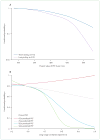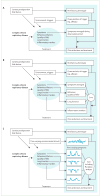Complexity of chronic asthma and chronic obstructive pulmonary disease: implications for risk assessment, and disease progression and control
- PMID: 18805337
- PMCID: PMC2752709
- DOI: 10.1016/S0140-6736(08)61450-6
Complexity of chronic asthma and chronic obstructive pulmonary disease: implications for risk assessment, and disease progression and control
Abstract
Although assessment of asthma control is important to guide treatment, it is difficult since the temporal pattern and risk of exacerbations are often unpredictable. In this Review, we summarise the classic methods to assess control with unidimensional and multidimensional approaches. Next, we show how ideas from the science of complexity can explain the seemingly unpredictable nature of bronchial asthma and emphysema, with implications for chronic obstructive pulmonary disease. We show that fluctuation analysis, a method used in statistical physics, can be used to gain insight into asthma as a dynamic disease of the respiratory system, viewed as a set of interacting subsystems (eg, inflammatory, immunological, and mechanical). The basis of the fluctuation analysis methods is the quantification of the long-term temporal history of lung function parameters. We summarise how this analysis can be used to assess the risk of future asthma episodes, with implications for asthma severity and control both in children and adults.
Conflict of interest statement
We declare that we have no conflict of interest.
Figures






References
-
- Global strategy for asthma management and prevention (GINA). NIH Publication No 02-3659. [(accessed July 1, 2008)]. 2007 Jan 1995 (updated 2007); 7. http://www.ginasthma.com/
-
- Chung KF, Godard P, Adelroth E, et al. Difficult/therapy-resistant asthma: the need for an integrated approach to define clinical phenotypes, evaluate risk factors, understand pathophysiology and find novel therapies. ERS Task Force on Difficult/Therapy-Resistant Asthma. European Respiratory Society. Eur Respir J. 1999;13:1198–208. - PubMed
-
- Plaza V, Serrano J, Picado C, Sanchis J. Frequency and clinical characteristics of rapid-onset fatal and near-fatal asthma. Eur Respir J. 2002;19:846–52. - PubMed
-
- van den Toorn LM, Overbeek SE, de Jongste JC, Leman K, Hoogsteden HC, Prins JB. Airway inflammation is present during clinical remission of atopic asthma. Am J Respir Crit Care Med. 2001;164:2107–13. - PubMed
Publication types
MeSH terms
Grants and funding
LinkOut - more resources
Full Text Sources
Other Literature Sources
Medical

